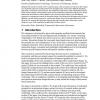Free Online Productivity Tools
i2Speak
i2Symbol
i2OCR
iTex2Img
iWeb2Print
iWeb2Shot
i2Type
iPdf2Split
iPdf2Merge
i2Bopomofo
i2Arabic
i2Style
i2Image
i2PDF
iLatex2Rtf
Sci2ools
PUC
2007
2007
Understanding movement for interaction design: frameworks and approaches
The results of a study of two computer games, that use human movement as direct input, were analysed using four existing frameworks and approaches, drawn from different disciplines that relate to interaction and movement. This enabled the exploration of the relationships between bodily actions and the corresponding responses from technology. Interaction analysis, two design frameworks and Laban movement analysis were chosen for their ability to provide different perspectives on human movement in interaction design. Each framework and approach provided a different, yet still useful, perspective to inform the design of movement-based interaction. Each allowed us to examine the interaction between the player and the game technology in quite distinctive ways. Each contributed insights that the others did not.
| Added | 27 Dec 2010 |
| Updated | 27 Dec 2010 |
| Type | Journal |
| Year | 2007 |
| Where | PUC |
| Authors | Lian Loke, Astrid Twenebowa Larssen, Toni Robertson, Jenny Edwards |
Comments (0)

